Exploring Hiroshima’s Peace Memorial Park is a solemn yet profound experience. Visitors embark on a 3-hour walking tour, seeing the city’s poignant history. They’ll encounter the iconic A-Bomb Dome, a haunting reminder of the past, before delving into the Peace Memorial Museum‘s chronicles of the atomic bombing’s devastation. This journey fosters contemplation and a commitment to peace, inviting travelers to reflect on the park’s symbolic significance.
Key Points
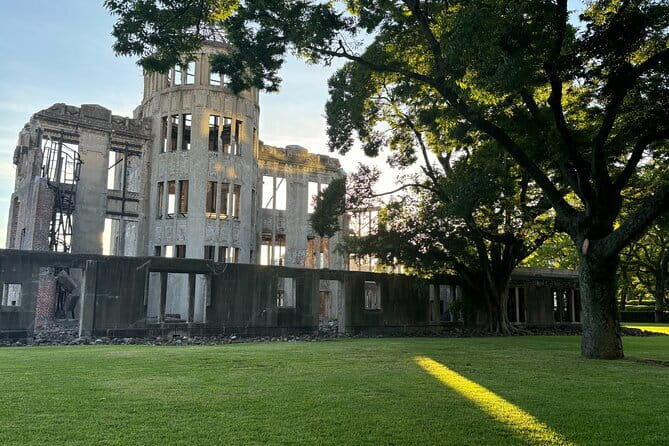
- Explore the Hiroshima Peace Memorial Park, a serene landscape that serves as a solemn reminder of the city’s tragic past.
- Visit the iconic A-Bomb Dome, a remnant of the 1945 atomic bombing, and understand its powerful symbolism.
- Enjoy the Peace Memorial Museum, which provides insights into the devastation and human toll of the atomic bombing.
- Witness the Children’s Peace Monument, a memorial honoring the victims and inspiring a commitment to peace.
- Reflect at the Cenotaph for the A-Bomb Victims, a stark reminder of the devastating consequences of nuclear warfare.
Exploring the Peace Memorial Park

As visitors explore the Hiroshima Peace Memorial Park, they’ll discover a serene and poignant landscape that serves as a powerful reminder of the city’s tragic past.
The park’s centerpiece is the iconic A-Bomb Dome, a haunting remnant of the 1945 atomic bombing. Nearby, the Peace Memorial Museum provides a comprehensive look at the devastation and human toll.
Meticulously maintained gardens and monuments honor the victims and promote peace. Visitors can reflect at the Children’s Peace Monument and the Flame of Peace, which will burn until the last nuclear weapon is eliminated.
Throughout, the park’s solemn atmosphere encourages contemplation and a commitment to non-violence.
If you're enjoying exploring Hiroshima on foot, you'll love these other walking tours we recommend
Visiting the Peace Memorial Museum
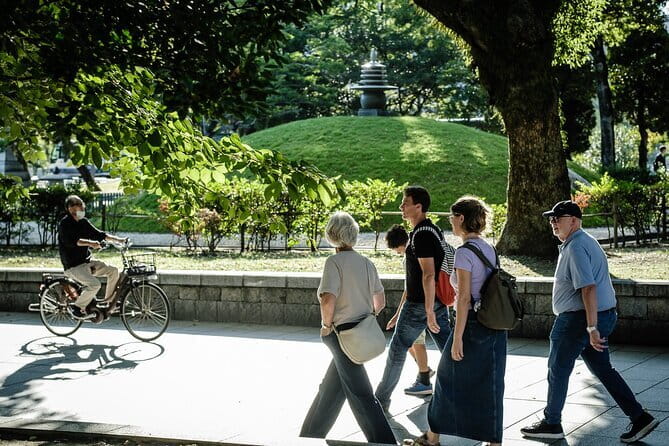
The Peace Memorial Museum stands as a poignant testament to Hiroshima’s tragic past. This somber institution chronicles the events of August 6, 1945, when the city was devastated by the atomic bomb.
Visitors can explore the museum’s exhibits, which include personal belongings, photographs, and survivor accounts. The museum’s powerful displays evoke the immense human suffering and the long-lasting effects of nuclear war.
Through the museum’s educational mission, visitors gain a deeper understanding of the horrors of the atomic bombing and its lasting impact on Hiroshima. The museum serves as a reminder of the need for peace and the importance of nuclear disarmament.
Witnessing the Atomic Bomb Dome
From the Peace Memorial Museum, visitors can then witness the haunting presence of the Atomic Bomb Dome, one of the most powerful and enduring symbols of the atomic bombing.
The skeletal remains of the former Prefectural Industrial Promotion Hall stand as a stark reminder of the devastation. Visitors can observe the building’s twisted steel frame and damaged brick walls, which have been preserved as a memorial.
The Atomic Bomb Dome serves as a solemn testament to the horrors of nuclear warfare and a call for global peace and disarmament.
Reflecting at the Children’s Peace Monument

After witnessing the haunting Atomic Bomb Dome, visitors can now reflect at the poignant Children’s Peace Monument.
This memorial honors Sadako Sasaki, a young girl who died from leukemia, a result of radiation exposure from the atomic bombing. The monument features a bronze statue of Sadako holding a paper crane, a symbol of peace and healing.
Visitors often leave folded paper cranes as tributes. The serene, contemplative atmosphere encourages reflection on the devastating impacts of nuclear weapons and the importance of peace.
This somber yet inspiring site reminds all who visit of the human cost of war.
Understanding the Cenotaph for the A-Bomb Victims
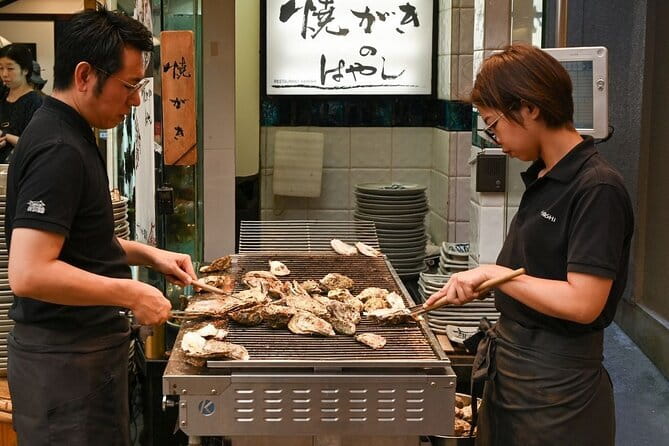
Opposite the Children’s Peace Monument stands the Cenotaph for the A-Bomb Victims, a stark reminder of the devastating consequences of nuclear warfare.
The simple stone arch design shelters a list of over 220,000 names – those who perished from the atomic blast and its aftermath. Visitors are encouraged to reflect on the immense human toll and to consider the ongoing impact of the tragedy.
The cenotaph serves as a powerful symbol, inspiring contemplation and a renewed commitment to peace. Its message resonates not just in Hiroshima, but around the world, urging us to prevent such catastrophic events from ever occurring again.
Here are more great tours and experiences we've reviewed in Hiroshima
Touring the Hiroshima National Peace Memorial Hall
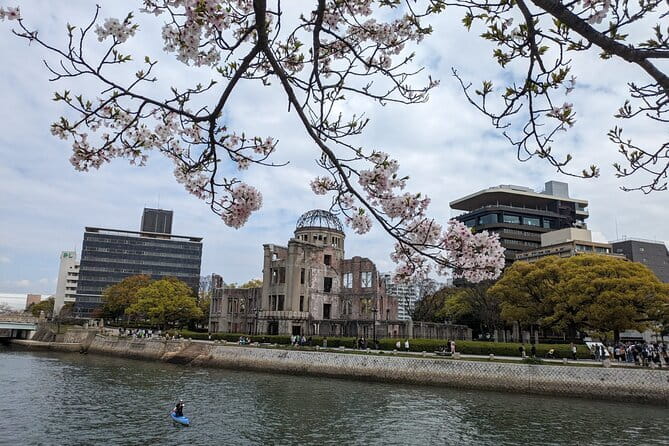
Next, visitors can explore the Hiroshima National Peace Memorial Hall, a somber and poignant landmark within the park.
This museum honors the victims of the atomic bombing and serves as a powerful reminder of the devastating impact of nuclear weapons. Visitors can view exhibits that detail the events leading up to the bombing, the experiences of survivors, and the ongoing efforts for peace and nuclear disarmament.
The hall’s architecture, with its minimalist design and use of natural materials, adds to the contemplative atmosphere. Touring the memorial hall provides a deeply reflective experience for visitors seeking to understand Hiroshima’s history and legacy.
Experiencing the Memorial Cathedral of Peace
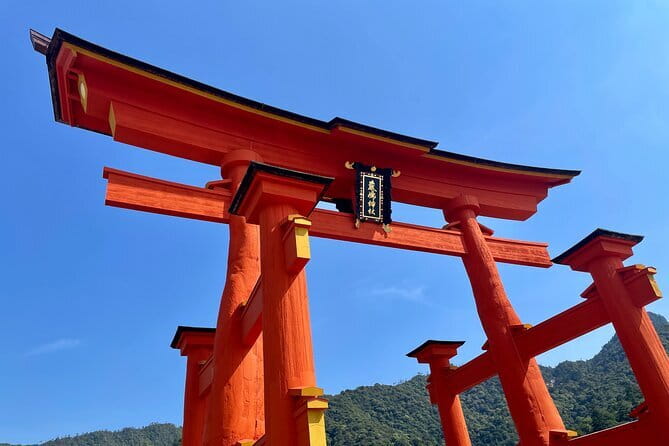
The Memorial Cathedral of Peace stands as a poignant landmark within the Hiroshima Peace Memorial Park. Visitors can explore this symbolic structure, which was designed by the renowned architect Tange Kenzō. The cathedral’s unique architectural design and reflective atmosphere create a powerful and contemplative experience.
| Feature | Description |
|---|---|
| Architecture | Modernist design with a striking A-frame silhouette |
| Materials | Concrete and glass, reflecting the devastation and resilience |
| Significance | Dedicated to the victims of the atomic bomb, a symbol of peace |
The Memorial Cathedral of Peace invites visitors to reflect on the past and consider the path towards a more peaceful future.
Appreciating the Park’s Symbolic Significance
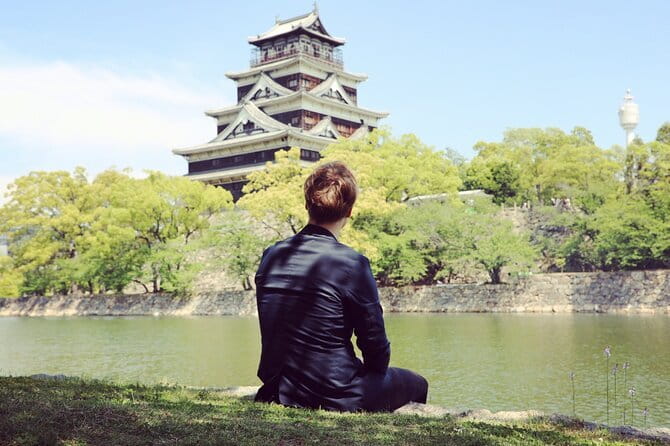
As visitors explore the Hiroshima Peace Memorial Park, they’ll discover the profound symbolic significance woven throughout the landscape.
The park’s design and monuments serve as a constant reminder of the horrors of nuclear war and the human desire for peace. From the iconic Atomic Bomb Dome to the Children’s Peace Monument, each element carries a powerful message.
The park’s serenity and contemplative atmosphere invite reflection on the past and hope for a future free from such devastation.
Visitors leave with a deeper understanding of the park’s solemn purpose and its enduring legacy as a symbol of peace.
Frequently Asked Questions
Is There a Dress Code for the Tour?
The tour doesn’t have a strict dress code, but visitors are advised to wear comfortable walking shoes and dress appropriately for the weather and site’s solemnity. Casual, respectful attire is recommended for the tour.
Can We Make Stops for Food and Restrooms?
The tour doesn’t include food or restroom stops, but your guide can provide recommendations on where to find them along the way. You’re free to take breaks as needed during the 3-hour tour.
What Is the Minimum Group Size for This Tour?
The minimum group size for this tour is 1 participant. The tour is priced per group, with a maximum of 10 participants allowed.
Can We Take Photos During the Tour?
Yes, guests can take photos during the tour. The guide will provide guidance on appropriate photo opportunities and etiquette within the Hiroshima Peace Memorial Park.
Are There Any Discounts Available for Seniors or Students?
Yes, the tour offers discounts for seniors and students. Seniors (aged 65 and above) can get a 10% discount, while students (with valid ID) can receive a 15% discount off the tour price.
Recap
Hiroshima Peace Memorial Park’s walking tour offers a profound and contemplative experience. Visitors can reflect on the city’s tragic past, honor the lives lost, and commit to peace while surrounded by beautifully maintained gardens. This journey fosters understanding, empathy, and a renewed dedication to preventing the horrors of nuclear warfare from happening again.
More Walking Tours in Hiroshima
- Hiroshima Peace Memorial Park Private Guided Walking Tour
- Historical Highlights of Hiroshima Walking Group Tour
- Hiroshima and Miyajima A Walk Through of History and Peace
- 4 Hour Private Hiroshima City Walking Tour
- 7 Hours Private Customizable Walking Tour in Hiroshima
- Historical Highlights of Hiroshima Group Walking Tour
More Tours in Hiroshima
- Emtb Tour to See the Beautiful Islands From the Summit
- Hiroshima & Miyajima Tour With English/Spanish Speaker Guide
- Hiroshima: Tomonoura Nostalgic Port Town Private Tour
- Bouldering, Sake and Food, Local Gem Hiroshima Evening Tour
- Hiroshima Night Tour: Craft Beer and Local Bites
- Hiroshima Peace Memorial and Highlights Private Tour With a Local
More Tour Reviews in Hiroshima
Not for you? Here's more things to do in Hiroshima we have recnetly reviewed
- 2 Best Dining Experiences In Hiroshima
- 2 Best Dinner Tours In Hiroshima
- 6 Best Full-Day Tours In Hiroshima
- 4 Best Lunch Experiences In Hiroshima
- 11 Best Food Tours In Hiroshima
- Hiroshima and Miyajima by Bike and Boat
- 5-Day ONE WAY Bus to North Hyogo From Fukuoka to Hiroshima
- Japan: 7-Day Tour of Tokyo, Osaka, Hiroshima & Okinawa
- 3-Day ONE WAY Bus Tour to Hiroshima via SANIN From Fukuoka
- Hiroshima Highlights Private Day Tour
- Hiroshima and Miyajima Day Trip From Kyoto/Osaka
- From Osaka/Kyoto: Hiroshima & Miyajima Private Guided Tour
